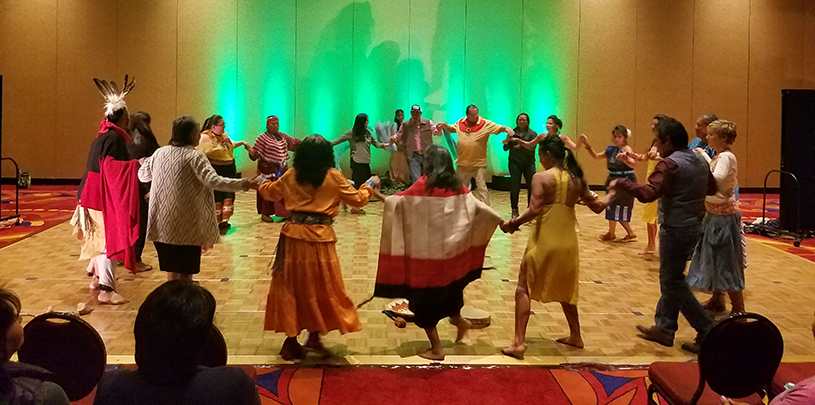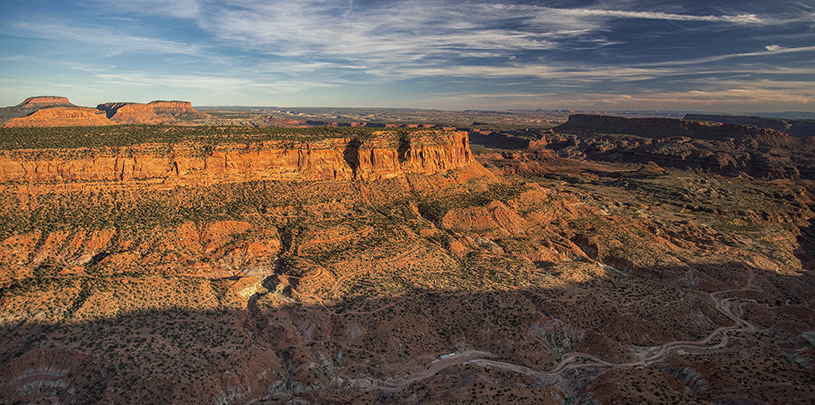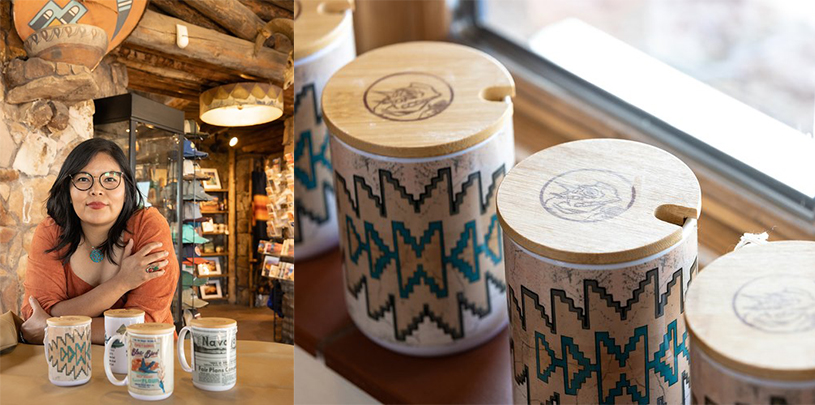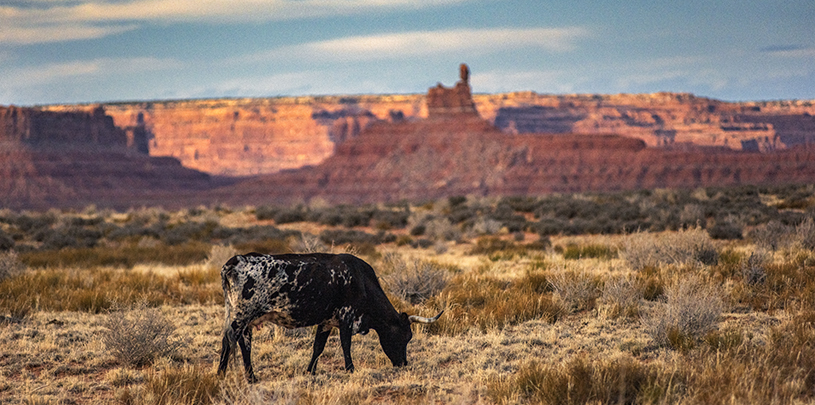
Havasupai women brought pomegranates harvested from their village at the bottom of the Grand Canyon. Hopi women brought blue cornmeal and an ear of white corn to place in a baby’s crib to ensure a long and healthy life. Navajo people brought a pottery vessel sealed with piñon sap. Visitors from Canada’s Mohawk nation offered sacred tobacco to the Pueblo of Pojoaque. Most spoke first in their Native languages and then repeated their words in English for the benefit of other Native people who had traveled from across the Southwest and from as far away as Canada and South America to attend the first-ever Indigenous Peoples’ Gathering for Healthy Communities, Culture, and Climate.
“Before this gathering, I used to call this Hopi tea,” Ruby Chimerica joked, offering a bag of medicinal tea. “But some people call it Navajo tea. Now I just call it intertribal tea.”
Centuries of cultural exchange
Since 2009, as Native people on the Colorado Plateau, we have been working to revitalize our once-thriving pre-colonial tradition of trade and cultural exchange by meeting to talk about issues many of our indigenous communities face, including preserving tribal language and culture, and protecting water, tribal health, and sacred sites. Reminders of our long history of exchange were on full display at the Indigenous Peoples’ Gathering when dancers from the Pueblo of Pojoaque performed a rain dance as part of the welcome ceremony. The female dancers carried rainclouds on their backs, represented by brilliant blue macaw feathers facing upward.
And, over the course of four days, we saw the four interconnected themes of the intertribal conversations group come to life, revitalizing this age-old tradition of trade and exchange.
Water
Protecting water is a big concern for tribal communities, especially in the desert Southwest, where the effects of climate change are already being felt, and where many of our Native peoples rely on traditional farming methods—including dry farming—to nurture crops. The rain dance brought water to the forefront immediately: male rain dancers wore the pelts of river otters and shells from the ocean, whose sound, as the Red Turtle Dance Group explained, mimics rainfall “so that the clouds know where to bring the water to us.”
Struggles to protect water from mining and development were also a topic of conversation. “We are fighting to protect our water source and our life in the Grand Canyon against uranium. As long as our feet are on this earth we are going to continue to fight to protect the canyon from uranium mining,” former Havasupai Tribal Councilwoman Carletta Tilousi shared after a Havasupai dance.
Sacred Sites
Bucky Preston, founder of the annual Hopi Water is Life ultra-run, led a morning run for gathering members and spoke about his own running practice and its connection to threats to sacred sites, including artificial snow-making on Arizona’s San Francisco Peaks and uranium mining proposed near New Mexico’s Mount Taylor. “We were born to touch the earth with our feet,” Preston said. “When we run, at the beginning there’s a prayer. I’ve used these legs, I’ve run thousands of miles. I run because our sacred mountain the San Francisco Peaks is being destroyed. I have been running, to bring awareness, I have run from my home to Phoenix 276 miles, from Phoenix to Zuni to home to Mt. Taylor. I have been running for a long time. I have been hurting in my left ankle, but I still ran this morning. The people who ran this morning they ran for all of you while you were still asleep, they ran for the whole world.”
“Our sacred sites are what heals us, they are our medicines, which is why we need to protect them from extractive industries or we can’t heal,” said Talia Boyd, of Tonalea, Navajo Nation who now works as an organizer for Conservation Voters, New Mexico. “Uranium mining on Mount Taylor jeopardizes the mental, physical, and spiritual health of indigenous communities,” Boyd explained.
Health
Roxanne Swentzell of the Pueblo of Santa Clara shared her work to encourage Native people to return to our traditional diets, before Europeans introduced sugar, alcohol, beef, wheat, and other foods. Swentzell, along with 13 other Puebloans, conducted the Puebloan Food Experience, eating nothing but traditional ancestral foods for three months, a process that lowered her high blood pressure, eliminated her high cholesterol, and improved her mood. “Food is medicine,” Swentzell said.
Billy Joe Swimmer of the Pine Ridge reservation in South Dakota delivered one of the gathering’s most moving keynotes on health issues, speaking frankly about how running has helped her overcome a childhood of sexual abuse, alcoholism, and abandonment. “We don’t like to talk about these things because these are not our Native ways, this is not who we are, but it is going on so we need to talk about it,” Swimmer said. When she finished, women from tribes across the continent stood up to thank her, express support, and share their own experiences.
Language and Culture
Throughout the gathering, Native people shared their languages and cultural traditions with other gathering members. Members of the Havasupai Tribe performed a basket dance, explaining that, in Havasupai Culture, after baskets are made, you have to dance in honor of them before they are used.
Dr. Devon G. Peña shared his experience as a traditional farmer. “Corn is sentient, the corn knows, if you are gentle with it,” he explained, sharing how he was able to make red corn given to him at Zuni Pueblo 30 years ago grow at a much higher altitude near his home in Colorado. “My grandmother was a gardener and a seed saver. She taught me. When I was ten, I asked her, ‘Why do you put your seeds in a jar by the stovetop?’ She said, ‘Because the seed is the memory of the plant of how to live well in this place.’”
Over four days in Pojoaque, tribal people gathered to reestablish connections, build relationships, and share their knowledge and understanding of how to live well in this place in the face of climate challenges. That long tradition of conversation, reignited, continues today.




